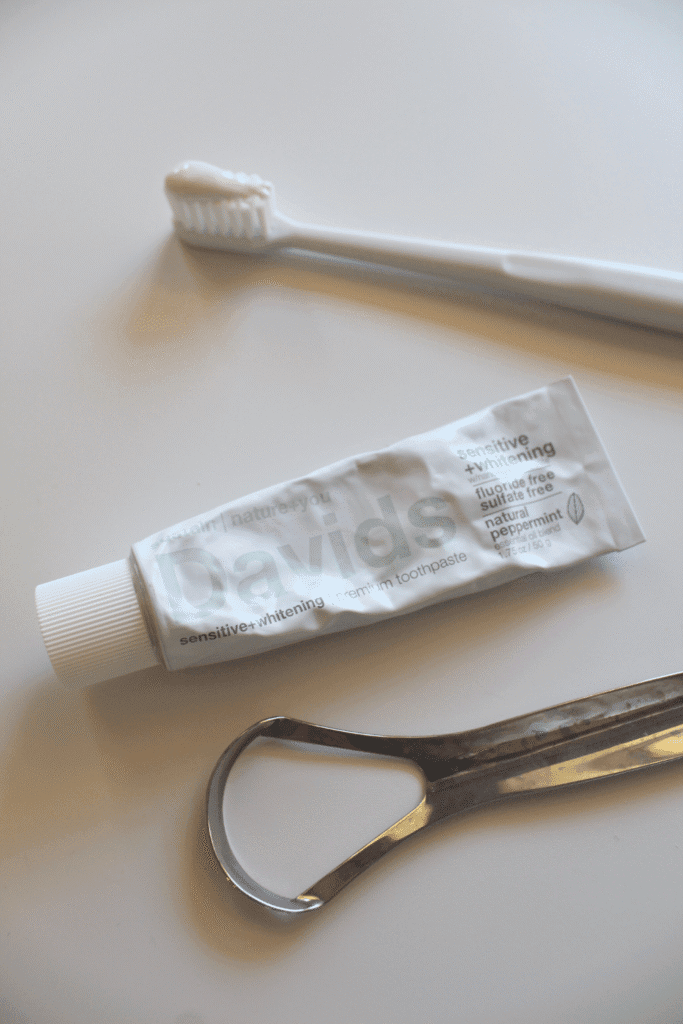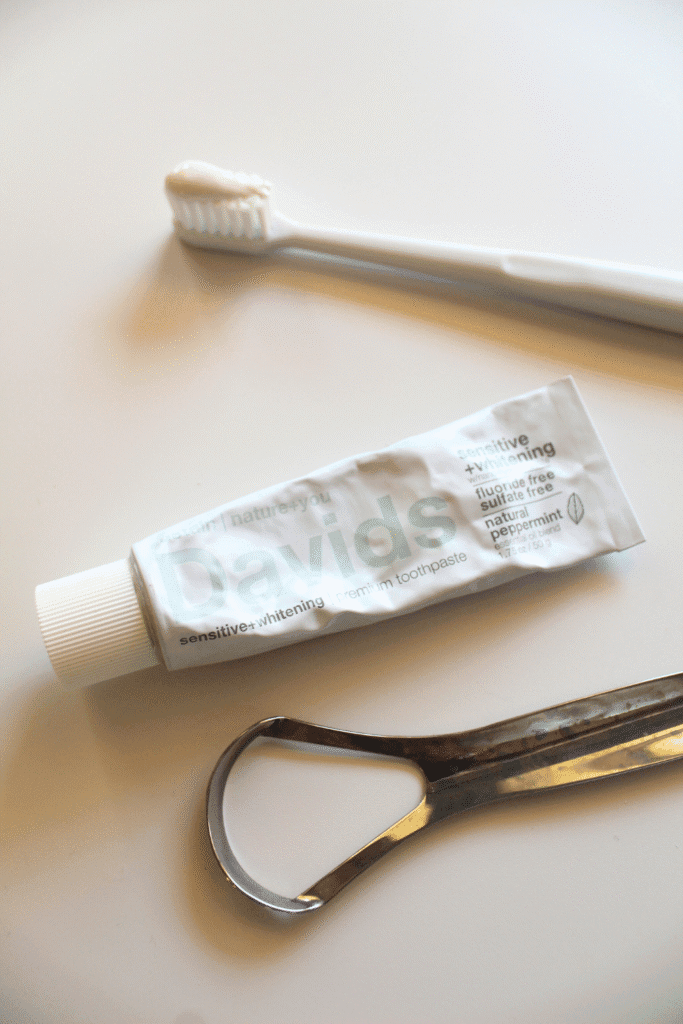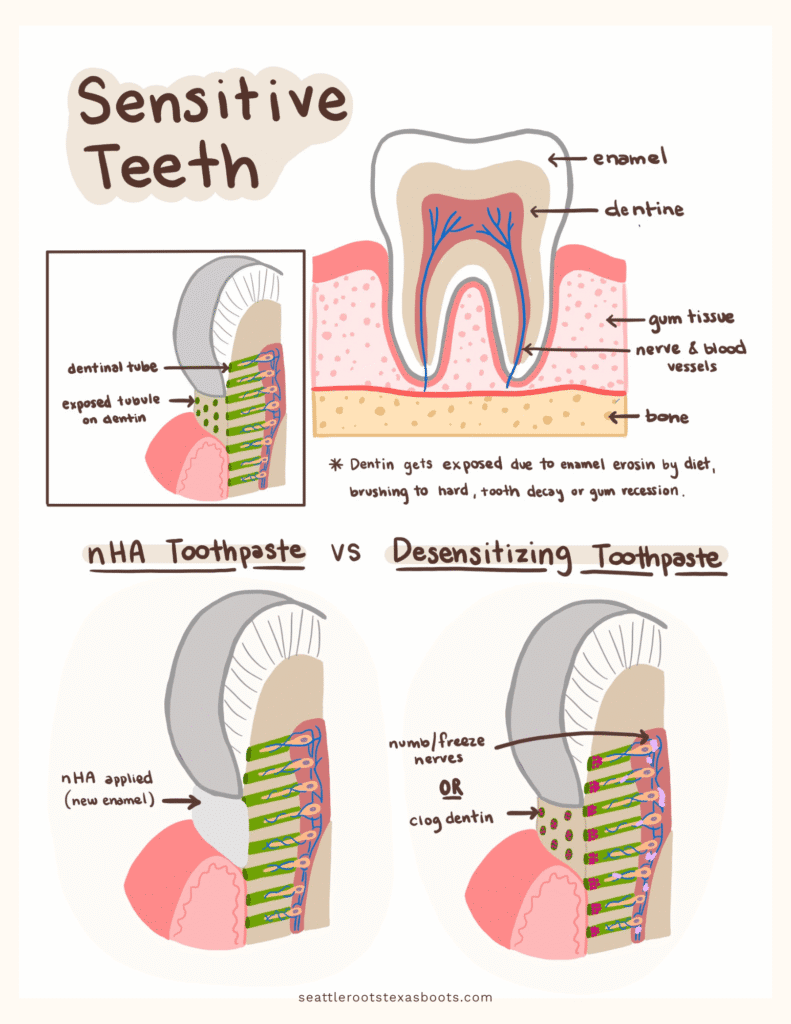Most of us think about what we put in our bodies—but what about what we put in our mouths every single day? Toothpaste is something we often overlook, but conventional options are full of unnecessary and even harmful ingredients.
When I began transitioning to a more natural, non-toxic lifestyle, oral care wasn’t the first thing on my list. But looking back on my history with cavities, gum issues, sensitive teeth and far too much dental work, it probably should have been. Once I paused to really consider what I was brushing with twice a day, it became clear: my toothpaste needed a serious upgrade.
After testing a few brands and different approaches, I finally found something that actually works—and that I feel good about using.
If you’re aiming to live more naturally, switching to a clean, non-toxic toothpaste is a small step with big impact. In this post, I’ll show you how to choose the best natural toothpaste, which ingredients to avoid, what the deal is with fluoride, and why I personally use nHA toothpaste every single day.

Explore some of my favorite recommended products to support your health journey (displayed on this page as affiliate links), and remember to always consult a healthcare professional before making any changes to your diet or lifestyle—full medical disclaimer here.
Why Switch to a natural Toothpaste?
Conventional toothpaste may make your teeth feel clean, but it often comes with unneeded extras—like harsh detergents, artificial dyes, and preservatives.
Your mouth is incredibly absorbent, meaning what you brush with doesn’t just rinse away—it can actually enter your bloodstream. Choosing a more natural option helps reduce your body’s chemical load and supports overall health.
And from what I’ve seen, many natural toothpaste brands don’t just avoid the bad stuff—they actually use ingredients that are more effective and beneficial for your teeth and gums.
Baking Soda in Toothpaste: Risk or Reward?
Baking soda is a safe, natural alternative to the harsh chemicals found in many conventional toothpastes. When used in the right concentration, it gently cleans and whitens without damaging enamel. It also helps neutralize acids and reduce bacteria—offering powerful benefits compared to similar acting ingredients in typical toothpastes.
What To Avoid In Toothpaste
Here are common ingredients I personally stay away from:
Sodium Lauryl Sulfate (SLS) – A foaming agent that can irritate gums, cause mouth sores, and dry out your mouth.
Artificial Sweeteners (like Aspartame and Saccharin) – These are often used to make toothpaste taste sweeter, but they can have health risks and contribute to an artificial feel.
Fluoride (if you’re opting out) – Some prefer to avoid fluoride because of concerns about overexposure or its potential effects on thyroid function and dental fluorosis. If you’re going for a fluoride-free option, check the label!
Triclosan – An antibacterial agent linked to hormone disruption and environmental harm, often still found in some “antibacterial” toothpastes.
Propylene Glycol – A chemical derived from petroleum, commonly used as a thickener, that can be irritating to sensitive skin and mucus membranes.
Titanium Dioxide – A whitening agent used in some toothpastes and foods, which may cause gut irritation and is a potential carcinogen when ingested in large amounts.
Parabens – Used as preservatives, parabens can interfere with hormone function, especially with prolonged exposure.
What To Look For In Natural Toothpaste
Here are ingredients I love to see on a label:
nHA (Nano-Hydroxyapatite): A science-backed, non-toxic alternative to fluoride that helps remineralize enamel and reduce sensitivity.
Xylitol: A natural sweetener that actually fights cavities.
Calcium carbonate or baking soda: Gently polishes and cleans without damaging enamel.
Coconut oil: Known for antibacterial properties, soothing the gums, freshens breath and helps with dry mouth.
Essential oils like peppermint, tea tree, or clove: Naturally freshen breath and fight germs. Also, is non-toxic compared to many artificial and even natural flavors.

Fluoride: Should You Use It?
Fluoride has been praised for its cavity-fighting powers, and in small amounts, it can be helpful. However, too much fluoride can lead to overexposure, especially in children or people with thyroid issues. I choose to skip fluoride for a few reasons:
We have fluoride in water already.
It can be harmful if swallowed regularly (especially for kids).
There are great natural alternatives—like nHA.
Why should you use Nano-hydroxyapatite?
I’ve had sensitive teeth for as long as I can remember. I assume much of it stems from the years of braces and extensive dental work I went through at a young age. For a while, I used desensitizing toothpaste—the kind designed to numb the nerves in your teeth and gums. While it took the edge off, the sensitivity to hot and cold never really went away. It always felt more like a band-aid than a real solution.
When I heard about nHA (nano-hydroxyapatite), I knew I had to give it a try—and within just a week, it was a night and day difference. Unlike traditional sensitivity toothpastes that simply numb the pain, nHA actually works to rebuild and remineralize tooth enamel, helping to heal the root cause of sensitivity. It was the first time I felt like my teeth were truly getting stronger, not just temporarily soothed.
Why nHA Is So Effective for Tooth Health
Nano-hydroxyapatite (nHA) is a game-changer in oral care—especially for those with sensitive teeth, enamel erosion, or a desire for a more natural alternative to fluoride. It was originally developed by NASA to help astronauts rebuild lost tooth and bone density in space, and it’s now becoming a popular ingredient in clean, natural toothpastes.
What makes nHA so powerful is that it’s biomimetic, meaning it mimics the natural material your teeth are made of. Enamel is about 97% hydroxyapatite, so when you brush with nHA, you’re giving your teeth exactly what they need to rebuild and remineralize.
Instead of just masking sensitivity like some desensitizing pastes, nHA actually helps fill in tiny cracks and weak spots in the enamel, strengthening teeth from the outside in. It also helps protect against cavities, smooths the tooth surface, and even reduces plaque by making it harder for bacteria to stick.
Another bonus? It’s safe to swallow and gentle enough for kids, making it an ideal fluoride-free option for the whole family.

My Favorite Natural Toothpaste
Tips for Switching to Natural Toothpaste
Don’t worry if it doesn’t foam—natural toothpaste usually doesn’t, and that’s a good thing.
Give it a couple of weeks—your mouth may take time to adjust.
Pair it with good brushing habits and a healthy diet.
Check labels every time—“natural” on the front doesn’t always mean clean ingredients inside.
I’ve tried quite a few natural toothpastes over the years—from chewable tablets to traditional pastes—but my favorite by far is Davids n-HA Sensitive+ toothpaste. I love how clean my mouth feels after brushing, and I’ve noticed a huge difference in my sensitivity since switching. Plus, Davids offers other formulas too, including non-sensitive varieties, kid-friendly versions, and a great range of flavors.
A close second for me would be Boka—their ingredients are just as clean and impressive, and they also use nHA. I just didn’t love the flavor options as much, and I didn’t feel like it left my mouth quite as fresh as Davids. That said, it’s still a fantastic choice, especially if you’re looking to ditch fluoride and avoid harsh ingredients.
Switching to a natural toothpaste might seem like a small change, but it can make a big impact over time. Your oral health is closely connected to your overall health, and what you put in your mouth daily matters. Choosing toothpaste with better, safer ingredients is one less thing to worry about in your wellness journey. Start small, stay curious, and find what truly works for you. Your smile—and your whole body—will thank you.
